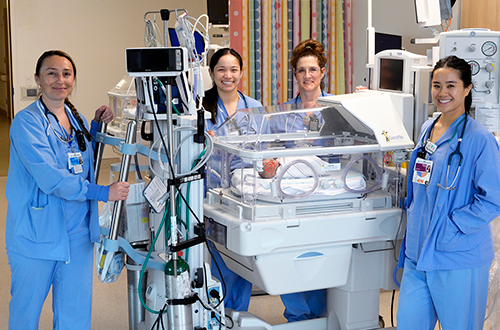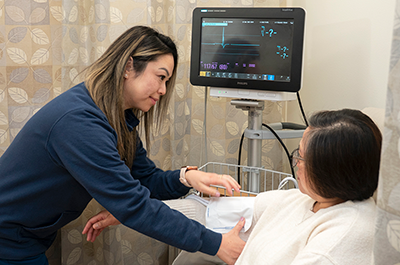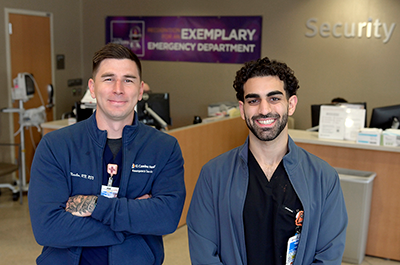Nursing Annual Report 2025 | Sailing Towards Magnet Mastery
Transformational Leadership |

Keeping Newborns Warm: A Life-Saving Improvement in the NICU
Why It Matters:
Newborns, especially preemies, are at high risk of hypothermia (dangerous drop in body temperature) because their bodies struggle to stay warm. This can lead to serious health problems like breathing issues, low blood sugar, and even increased mortality. The first few minutes after birth are critical, as babies can lose heat quickly.

(from left) Ganessa Ladiano, RT; Nichole Villamin, RN; Diane Crothers, RN; Mikaela Castro, RN
Identifying the Problem:
Our NICU team, in partnership with the California Perinatal Quality Care Collaborative (CPQCC), tracks newborn admission temperatures. When data showed that a significant percentage of babies admitted had suboptimal temperatures, the NICU Small Baby Taskforce took action.
The Breakthrough:
The Suboptimal Temperature Project team discovered that babies needing breathing support (bubble CPAP) were disconnected from warm, humidified oxygen during transport, causing their temperature to drop. To fix this, they researched ways to keep babies warm while moving them to the NICU.
The Solution:
The team proposed using the Giraffe™ Shuttle™, a transport system that keeps newborns warm and stable. After approval, the Shuttle was purchased, and staff received training. It then became the standard for transporting newborns from Labor & Delivery and the Operating Room.
The Results:
Since implementing the Giraffe™ Shuttle™, suboptimal temperatures on NICU admission dropped by nearly 68-percent! This major improvement has now become a best practice in our NICU, ensuring better outcomes for our tiniest patients.
This success highlights the power of teamwork, research, and evidence-based care in making a real difference for newborns.
Enhancing Emergency Department Efficiency & Patient Satisfaction
Addressing Increasing Wait Times:
The Mountain View Emergency Department (MV ED) identified increasing wait times and declining patient satisfaction scores. Research confirms that prolonged wait times negatively impact patient experience, making it essential to improve efficiency and overall care quality.

Catherine Tran, RN, ED, providing care
Key Challenges Identified:
- Extended Door-to-Discharge Time: Patients spent an average of 200 minutes in the ED.
- Triage & Flow Issues: Inconsistent triage assessments led to delays.
- Resource Limitations: Staffing shortages during peak hours affected patient care.
Nurse-Led Interventions & Process Improvements:
- Triage Process Improvement
- Clinical nurses identified inconsistencies in triage assessments and worked with leadership to implement a two-step triage system for faster, more accurate patient evaluations.
- Nurse-Led Training: Nurses developed and delivered a mandatory Emergency Severity Index (ESI) training, ensuring all ED nurses could accurately assess patient acuity.
- Nurses provided feedback in daily huddles, staff meetings, and the Unit Partnership Council (UPC) to refine triage workflows.
- Optimizing Staffing & Patient Flow
- Frontline nurses analyzed patient volume trends and advocated for additional staffing during high-traffic hours, resulting in the addition of an extra nurse and ED technician designated for the waiting room.
- Creation of the Front-End Nurse (FEN) Role: Nurses played a key role in designing this position, writing the job description for the role, managing patient flow, coordinating care in the waiting room, and escalating treatment as needed.
- Nurses collaborated with leadership to redesign waiting room operations, including adding recliners for minor cases to improve comfort and efficiency.
- Streamlining Operations & Enhancing Care Delivery
- Nurses helped implement rapid Point-of-Care Testing (LIAT machines), reducing diagnostic turnaround times.
- Clinical nurses worked alongside medical leadership to introduce an assigned provider at Triage, so Medical Screening Exams (MSE) were completed on all patients. Nurses started the initiation of care order (IOC) after the medical screening was completed to facilitate patients flow during peak hours.
- Nurses advocated for process changes that empowered them to initiate orders, enabling faster interventions for patients in need.
Results & Impact:
- Improved patient throughput & satisfaction due to better triage, staffing, and resource allocation.
- Enhanced nurse leadership & collaboration, with frontline nurses directly shaping ED process improvements.
- Increased Press Ganey “Likelihood to Recommend” score, reflecting positive patient experiences and satisfaction.
Through nurse-led innovation, collaboration with leadership, and targeted process improvements, MV ED successfully reduced wait times, enhanced patient care, and strengthened its commitment to high-quality emergency services.
Promoting Workplace Safety in the Emergency Department

(from left) Jordan Norrbom, RN; Shayan Shafikhani, RN, Emergency Department
Background:
Workplace violence is a growing concern in healthcare, with incidents occurring at rates much higher than in other industries. At El Camino Health, ensuring a safe work environment is a top priority, especially in high-risk areas like the Emergency Department (ED). Despite our zero-tolerance policy for workplace violence, opportunities for improvement were identified.
Project Overview:
In January 2024, ED nurse residents Shayan Shafikhani, BSN, RN, and Jordan Norrbom, BSN, RN, as part of the nurse residency program, led an evidence-based practice (EBP) project to enhance security measures in the ED, under the mentorship of Yasmine Perdue, DNP, FNP, CEN.
The project consisted of reviewing the literature, surveying the ED staff, and developing tactics to address the identified issues.
Recommendations & Actions Taken:
Based on research and survey responses, the following changes were implemented:
- March 2024: Plans were initiated to relocate the security desk to the front, making security personnel the first point of contact.
- May 2024: Desk relocation was completed, improving visibility and response times.
- June 2024: Panic buttons were installed at the screener desk and psychiatric holding area for immediate security alerts.
Impact:
These changes have already led to improved staff perceptions of safety. The project outcomes are continuously monitored through ED meetings, ensuring ongoing improvements to workplace security. By prioritizing safety, El Camino Health is fostering a more secure environment for both staff and patients.
